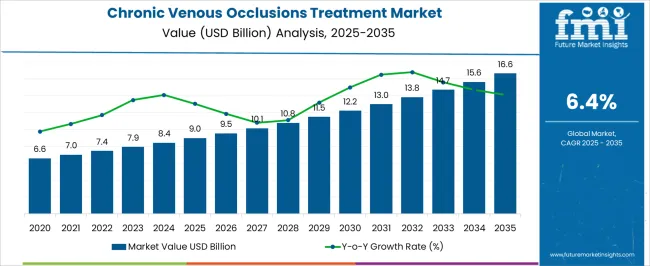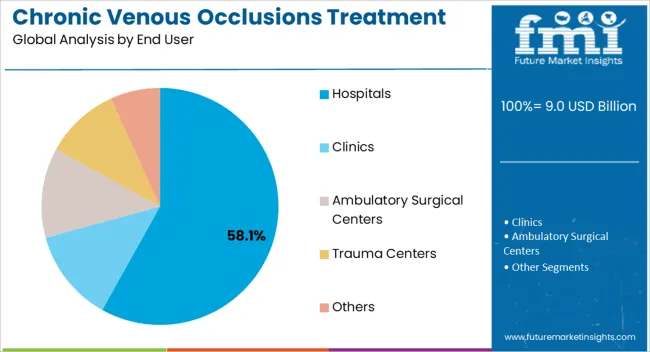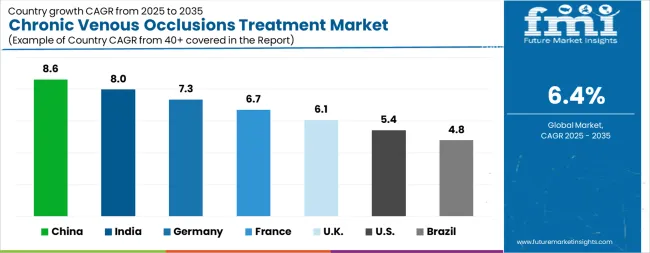The Chronic Venous Occlusions Treatment Market is estimated to be valued at USD 9.0 billion in 2025 and is projected to reach USD 16.6 billion by 2035, registering a compound annual growth rate (CAGR) of 6.4% over the forecast period.

| Metric | Value |
|---|---|
| Chronic Venous Occlusions Treatment Market Estimated Value in (2025 E) | USD 9.0 billion |
| Chronic Venous Occlusions Treatment Market Forecast Value in (2035 F) | USD 16.6 billion |
| Forecast CAGR (2025 to 2035) | 6.4% |
The Chronic Venous Occlusions Treatment market is being driven by the increasing prevalence of venous diseases among aging populations, combined with advancements in minimally invasive treatment techniques. The current market scenario reflects a growing preference for outpatient and image-guided procedures that reduce hospital stays and post-treatment complications. The rising awareness of venous health, coupled with the demand for early diagnosis and intervention, is supporting the expansion of treatment options.
Furthermore, improvements in medical imaging, catheter-based therapies, and laser-assisted interventions are making treatments more accessible and less invasive. The future outlook for the market is favorable, with rising healthcare infrastructure investments, especially in developing regions.
Increased adoption of advanced treatment protocols, growing patient preference for quicker recovery, and a shift toward personalized and targeted therapies are expected to create additional growth opportunities The expansion of healthcare access, supportive insurance frameworks, and physician training in newer techniques are likely to further boost the adoption of treatment options for venous occlusions across both urban and rural settings.
The chronic venous occlusions treatment market is segmented by treatment type, applications, end user, and geographic regions. By treatment type, chronic venous occlusions treatment market is divided into Endovenous Laser Ablation, Compression Therapy, Radiofrequency Ablation, Deep Vein Insufficiency, Venous Obstruction, Chronic Deep Vein Thrombosis, Vein-Stripping, Non-Thermal Techniques, Sclerotherapy, Mechanochemical Ablation, and Cyanoacrylate.
In terms of applications, chronic venous occlusions treatment market is classified into Vascular, Urology, Neurovascular, Coronary, Cardiology, Gynecology, and Others. Based on end user, chronic venous occlusions treatment market is segmented into Hospitals, Clinics, Ambulatory Surgical Centers, Trauma Centers, and Others.
Regionally, the chronic venous occlusions treatment industry is classified into North America, Latin America, Western Europe, Eastern Europe, Balkan & Baltic Countries, Russia & Belarus, Central Asia, East Asia, South Asia & Pacific, and the Middle East & Africa.

The Endovenous Laser Ablation treatment type is expected to hold 32.60% of the Chronic Venous Occlusions Treatment market revenue in 2025, making it the leading segment. The growth of this segment has been supported by the procedure’s minimally invasive nature, reduced risk of infection, and lower post-treatment discomfort compared to traditional surgical approaches. The ability to perform the procedure with local anesthesia, shorter hospital stays, and faster patient recovery has significantly contributed to its increased use.
Furthermore, advancements in laser technology and imaging techniques have improved the precision and safety of the procedure, making it a preferred option among healthcare providers. The segment’s expansion has also been influenced by increasing patient awareness and physician preference for safer and less invasive treatment options.
Rising investments in healthcare infrastructure and growing emphasis on patient-centric care are expected to sustain the segment’s strong position The scalability of the procedure in both high-end healthcare facilities and outpatient centers has further reinforced its leadership within the treatment type category.

The Vascular applications segment is projected to hold 37.40% of the Chronic Venous Occlusions Treatment market revenue in 2025, positioning it as the largest application area. The segment’s dominance has been attributed to the high incidence of venous disorders that require targeted interventions in vascular structures, especially among elderly and comorbid patient groups. Growing recognition of venous insufficiency as a significant health concern, alongside advances in diagnostic imaging, has increased referrals and treatment volumes.
Moreover, the availability of advanced therapies such as catheter-based interventions, laser treatments, and minimally invasive procedures has further enhanced treatment outcomes and reduced complications. The segment’s growth has been supported by the increasing number of vascular specialists and training programs focusing on advanced interventions.
Improved healthcare infrastructure, patient access to outpatient facilities, and insurance coverage for minimally invasive procedures have also contributed to the expanding demand With continued emphasis on preventive care and early intervention, vascular applications are expected to remain the largest segment within the chronic venous occlusions treatment landscape.

The Hospitals end user segment is anticipated to account for 58.10% of the Chronic Venous Occlusions Treatment market revenue in 2025, making it the largest end user category. The dominance of hospitals has been driven by their ability to offer advanced diagnostic tools, specialized medical staff, and access to high-end treatment technologies such as laser-assisted interventions and catheter-guided procedures. Hospitals are increasingly becoming the preferred treatment centers due to the availability of multidisciplinary care teams, structured recovery protocols, and post-treatment monitoring services.
The segment’s growth has been supported by rising patient volumes, particularly among aging populations with chronic venous conditions requiring expert care. Furthermore, hospitals have been able to provide safer environments for complex treatments, supported by stringent hygiene protocols and in-house imaging facilities.
Increasing insurance coverage for hospital-based procedures and patient preference for comprehensive treatment settings have reinforced the segment’s position As healthcare investments continue to expand and new treatment techniques are adopted, hospitals are expected to retain their leadership as the primary point of care for chronic venous occlusions treatment.
Chronic venous occlusions treatment is used to treat chronic venous occlusions. The treatment of clots in the deep vein with an anticoagulant may be resolved or may cause scar inside the tissue. The scar caused inside the tissue of the vein either damage the valves by causing backward flow or can cause blockage in the vein due to abnormal blood flow to the heart.
This blockage in the vein is known as chronic venous occlusions. The poor blood flow due to blockage increase the possibility for the chronic venous occlusions. The symptoms of chronic venous occlusions are the heavy or swelling of leg or skin discoloration. Chronic venous occlusions treatment has a high adoption rate due to the increasing prevalence of chronic venous diseases. According to the National Center for Biotechnology Information, more than 30 Mn population have some form of chronic venous disease in the US.
The prevalence of a chronic venous disease is 10 times more than peripheral artery diseases. Increased availability of advanced chronic venous occlusions treatment & devices and increasing adoption of minimally invasive procedures are the key factors for the growth of the global chronic venous occlusions treatment market.
However, poor lifestyle & hygiene which increases the chances of obesity, blood pressure, hormonal disorders, and sleep disorders can restraint the growth of chronic venous occlusions treatment market. Additionally, increasing genetic disorder and rising number of geriatric population can also affect the growth of chronic venous occlusions treatment market.
Over the past years, various options available for chronic venous occlusions treatment have evolved. The increase in demand for less invasive treatments to treat chronic venous occlusions, along with growing investments in research and development by the key market players to develop novel and effective treatments options and products is likely to increase the chronic venous occlusions treatment market. Additionally, aging population have high possibility to develop chronic venous occlusions.
Obese and pregnant women are also prone to chronic venous occlusions. This increasing number of patient pool rising the demand for better treatment options to treat chronic venous occlusions which boosting the growth of the chronic venous occlusions treatment market.
Some available chronic venous occlusions treatment in the market are compression therapy, endovenous laser ablation, radiofrequency ablation, deep vein insufficiency, venous obstruction, chronic deep vein thrombosis, vein-stripping, Sclerotherapy, mechanochemical ablation, and cyanoacrylate.

| Country | CAGR |
|---|---|
| China | 8.6% |
| India | 8.0% |
| Germany | 7.3% |
| France | 6.7% |
| UK | 6.1% |
| USA | 5.4% |
| Brazil | 4.8% |
The Chronic Venous Occlusions Treatment Market is expected to register a CAGR of 6.4% during the forecast period, exhibiting varied country level momentum. China leads with the highest CAGR of 8.6%, followed by India at 8.0%.
Developed markets such as Germany, France, and the UK continue to expand steadily, while the USA is likely to grow at consistent rates. Brazil posts the lowest CAGR at 4.8%, yet still underscores a broadly positive trajectory for the global Chronic Venous Occlusions Treatment Market. In 2024, Germany held a dominant revenue in the Western Europe market and is expected to grow with a CAGR of 7.3%.
The USA Chronic Venous Occlusions Treatment Market is estimated to be valued at USD 3.3 billion in 2025 and is anticipated to reach a valuation of USD 5.7 billion by 2035. Sales are projected to rise at a CAGR of 5.4% over the forecast period between 2025 and 2035. While Japan and South Korea markets are estimated to be valued at USD 418.6 million and USD 224.8 million respectively in 2025.

| Item | Value |
|---|---|
| Quantitative Units | USD 9.0 Billion |
| Treatment Type | Endovenous Laser Ablation, Compression Therapy, Radiofrequency Ablation, Deep Vein Insufficiency, Venous Obstruction, Chronic Deep Vein Thrombosis, Vein-Stripping, Non-Thermal Techniques, Sclerotherapy, Mechanochemical Ablation, and Cyanoacrylate |
| Applications | Vascular, Urology, Neurovascular, Coronary, Cardiology, Gynecology, and Others |
| End User | Hospitals, Clinics, Ambulatory Surgical Centers, Trauma Centers, and Others |
| Regions Covered | North America, Europe, Asia-Pacific, Latin America, Middle East & Africa |
| Country Covered | United States, Canada, Germany, France, United Kingdom, China, Japan, India, Brazil, South Africa |
| Key Companies Profiled | Cardinal Health, Stryker, Boston Scientific Corporation, and Edward Lifesciences |
The global chronic venous occlusions treatment market is estimated to be valued at USD 9.0 billion in 2025.
The market size for the chronic venous occlusions treatment market is projected to reach USD 16.6 billion by 2035.
The chronic venous occlusions treatment market is expected to grow at a 6.4% CAGR between 2025 and 2035.
The key product types in chronic venous occlusions treatment market are endovenous laser ablation, compression therapy, radiofrequency ablation, deep vein insufficiency, venous obstruction, chronic deep vein thrombosis, vein-stripping, non-thermal techniques, sclerotherapy, mechanochemical ablation and cyanoacrylate.
In terms of applications, vascular segment to command 37.4% share in the chronic venous occlusions treatment market in 2025.






Our Research Products

The "Full Research Suite" delivers actionable market intel, deep dives on markets or technologies, so clients act faster, cut risk, and unlock growth.

The Leaderboard benchmarks and ranks top vendors, classifying them as Established Leaders, Leading Challengers, or Disruptors & Challengers.

Locates where complements amplify value and substitutes erode it, forecasting net impact by horizon

We deliver granular, decision-grade intel: market sizing, 5-year forecasts, pricing, adoption, usage, revenue, and operational KPIs—plus competitor tracking, regulation, and value chains—across 60 countries broadly.

Spot the shifts before they hit your P&L. We track inflection points, adoption curves, pricing moves, and ecosystem plays to show where demand is heading, why it is changing, and what to do next across high-growth markets and disruptive tech

Real-time reads of user behavior. We track shifting priorities, perceptions of today’s and next-gen services, and provider experience, then pace how fast tech moves from trial to adoption, blending buyer, consumer, and channel inputs with social signals (#WhySwitch, #UX).

Partner with our analyst team to build a custom report designed around your business priorities. From analysing market trends to assessing competitors or crafting bespoke datasets, we tailor insights to your needs.
Supplier Intelligence
Discovery & Profiling
Capacity & Footprint
Performance & Risk
Compliance & Governance
Commercial Readiness
Who Supplies Whom
Scorecards & Shortlists
Playbooks & Docs
Category Intelligence
Definition & Scope
Demand & Use Cases
Cost Drivers
Market Structure
Supply Chain Map
Trade & Policy
Operating Norms
Deliverables
Buyer Intelligence
Account Basics
Spend & Scope
Procurement Model
Vendor Requirements
Terms & Policies
Entry Strategy
Pain Points & Triggers
Outputs
Pricing Analysis
Benchmarks
Trends
Should-Cost
Indexation
Landed Cost
Commercial Terms
Deliverables
Brand Analysis
Positioning & Value Prop
Share & Presence
Customer Evidence
Go-to-Market
Digital & Reputation
Compliance & Trust
KPIs & Gaps
Outputs
Full Research Suite comprises of:
Market outlook & trends analysis
Interviews & case studies
Strategic recommendations
Vendor profiles & capabilities analysis
5-year forecasts
8 regions and 60+ country-level data splits
Market segment data splits
12 months of continuous data updates
DELIVERED AS:
PDF EXCEL ONLINE
Chronic Sarcoidosis Therapeutics Market Size and Share Forecast Outlook 2025 to 2035
Chronic Phase Markers Market Size and Share Forecast Outlook 2025 to 2035
Chronic Lymphocytic Leukemia Therapeutics Market Size and Share Forecast Outlook 2025 to 2035
Chronic Lymphocytic Leukemia Market Size and Share Forecast Outlook 2025 to 2035
Chronic Dryness Repair Market Analysis - Size and Share Forecast Outlook 2025 to 2035
Chronic Skin Redness Care Market Size and Share Forecast Outlook 2025 to 2035
Chronic Hepatitis B Virus Testing Market Size and Share Forecast Outlook 2025 to 2035
The Chronic Wound Care Market is segmented by product, wound type and distribution channel from 2025 to 2035
Chronic Disease Management Market Size and Share Forecast Outlook 2025 to 2035
Chronic Brain Damage Treatment: Trends, Growth, and Key Developments
Chronic Granulomatous Disease (CGD) Management Market – Size, Share & Trends 2025 to 2035
Chronic Pain Market Analysis – Growth, Demand & Forecast 2024 to 2034
Chronic Obstructive Pulmonary Disease (COPD) Market Trends – Growth & Forecast 2023-2033
Chronic Refractory Cough Treatment Market – Growth & Innovations 2025 to 2035
Chronic Respiratory Diseases Treatment Market
Chronic Smell and Flavor Loss Treatment Market – Innovations & Growth 2025 to 2035
Chronic Pulmonary Hypertension Treatment Market Analysis and Forecast by Drug Type, Route of Administration, Distribution Channel, Region through 2035
Chronic immune thrombocytopenia treatment Market Size and Share Forecast Outlook 2025 to 2035
Late Stage Chronic Kidney Disease Therapeutics Market Size and Share Forecast Outlook 2025 to 2035
Venous Stents Market Size and Share Forecast Outlook 2025 to 2035

Thank you!
You will receive an email from our Business Development Manager. Please be sure to check your SPAM/JUNK folder too.
Chat With
MaRIA